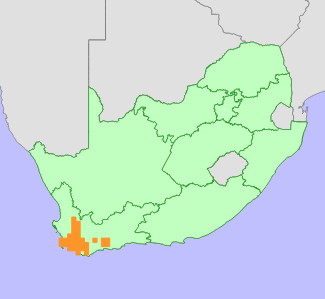|
Scientific Name | Gladiolus hirsutus Jacq. |
Higher Classification | Monocotyledons |
Family | IRIDACEAE |
Synonyms | Gladiolus pilosus Eckl., Gladiolus punctulatus Schrank, Gladiolus punctulatus Schrank var. autumnalis G.J.Lewis, Gladiolus punctulatus Schrank var. punctulatus, Gladiolus villosus Ker Gawl. |
Common Names | Lapmuis (a) |
National Status |
Status and Criteria | Least Concern |
Assessment Date | 2020/02/20 |
Assessor(s) | L. von Staden |
Justification | Gladiolus hirsutus is widespread, common and not in danger of extinction. It has an extent of occurrence (EOO) of 31 027 km², and is listed as Least Concern. |
Distribution |
Endemism | South African endemic |
Provincial distribution | Western Cape |
Range | This species is endemic to the mountains of the Western Cape of South Africa, where it occurs from the Koue Bokkeveld to the Cape Peninsula, and eastwards along the Langeberg to Robinson Pass. |
Habitat and Ecology |
Major system | Terrestrial |
Major habitats | Boland Granite Fynbos, Hawequas Sandstone Fynbos, Kogelberg Sandstone Fynbos, Elgin Shale Fynbos, Swartland Alluvium Fynbos, Peninsula Granite Fynbos, Cape Winelands Shale Fynbos, Overberg Sandstone Fynbos, Winterhoek Sandstone Fynbos, South Sonderend Sandstone Fynbos, Peninsula Sandstone Fynbos, Breede Shale Fynbos, Breede Alluvium Fynbos, Lourensford Alluvium Fynbos, Swellendam Silcrete Fynbos, Cape Flats Sand Fynbos, Hangklip Sand Fynbos, Agulhas Sand Fynbos, Breede Sand Fynbos, Elim Ferricrete Fynbos, Kouebokkeveld Shale Fynbos, North Sonderend Sandstone Fynbos, Peninsula Shale Fynbos, Kouebokkeveld Alluvium Fynbos, South Langeberg Sandstone Fynbos, Swartland Granite Renosterveld, Greyton Shale Fynbos, Montagu Shale Fynbos, Breede Quartzite Fynbos, North Langeberg Sandstone Fynbos, Cederberg Sandstone Fynbos |
Description | It occurs on stony sandstone or granite lower mountain slopes. |
Threats |
| About 17% of this species' habitat is irreversibly modified, predominantly due to historical loss to timber plantations. Plantations are no longer expanding, but some subpopulations near plantations are threatened by competition from escaped pine seedlings that are spreading in to native fynbos vegetation. |
Population |
Gladiolus hirsutus is common across its range, and there are more than 100 subpopulations. The population is not suspected to be declining.
|
Population trend | Stable |
Assessment History |
Taxon assessed |
Status and Criteria |
Citation/Red List version | | Gladiolus hirsutus Jacq. | Least Concern | Raimondo et al. (2009) | | Gladiolus punctulatus Schrank var. punctulatus | Not Threatened | Hilton-Taylor (1996) | | Gladiolus punctulatus Schrank var. punctulatus | Rare | Hall et al. (1980) | | Gladiolus punctulatus Schrank var. autumnalis G.J.Lewis | Rare | Hall et al. (1980) | |
Bibliography |
Goldblatt, P. and Manning, J.C. 1998. Gladiolus in southern Africa. Fernwood Press, Vlaeberg.
Hall, A.V., De Winter, M., De Winter, B. and Van Oosterhout, S.A.M. 1980. Threatened plants of southern Africa. South African National Scienctific Programmes Report 45. CSIR, Pretoria.
Hilton-Taylor, C. 1996. Red data list of southern African plants. Strelitzia 4. South African National Botanical Institute, Pretoria.
Manning, J.C. and Goldblatt, P. 2012. Plants of the Greater Cape Floristic Region 1: The Core Cape Flora. Strelitzia 29. South African National Biodiversity Institute, Pretoria.
Raimondo, D., von Staden, L., Foden, W., Victor, J.E., Helme, N.A., Turner, R.C., Kamundi, D.A. and Manyama, P.A. 2009. Red List of South African Plants. Strelitzia 25. South African National Biodiversity Institute, Pretoria.
|
Citation |
| von Staden, L. 2020. Gladiolus hirsutus Jacq. National Assessment: Red List of South African Plants version . Accessed on 2025/09/20 |
 Comment on this assessment
Comment on this assessment

